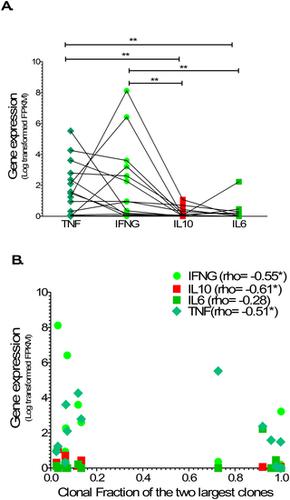当前位置:
X-MOL 学术
›
PLOS Pathog.
›
论文详情
Our official English website, www.x-mol.net, welcomes your
feedback! (Note: you will need to create a separate account there.)
Switching and loss of cellular cytokine producing capacity characterize in vivo viral infection and malignant transformation in human T- lymphotropic virus type 1 infection.
PLoS Pathogens ( IF 5.5 ) Pub Date : 2018-02-14 , DOI: 10.1371/journal.ppat.1006861 Huseini Kagdi 1 , Maria Antonietta Demontis 1 , Juan Carlos Ramos 2 , Graham P Taylor 1
PLoS Pathogens ( IF 5.5 ) Pub Date : 2018-02-14 , DOI: 10.1371/journal.ppat.1006861 Huseini Kagdi 1 , Maria Antonietta Demontis 1 , Juan Carlos Ramos 2 , Graham P Taylor 1
Affiliation

|
Adult T-cell leukaemia/lymphoma (ATL) arises from chronic non-malignant human T lymphotropic virus type-1 (HTLV-1) infection which is characterized by high plasma pro-inflammatory cytokines whereas ATL is characterized by high plasma anti-inflammatory (IL-10) concentrations. The poor prognosis of ATL is partly ascribed to disease-associated immune suppression. ATL cells have a CD4+CCR4+CD26-CD7- immunophenotype but infected cells with this immunophenotype ('ATL-like' cells) are also present in non-malignant HTLV-1 infection. We hypothesized that 'ATL-like' and ATL cells have distinct cytokine producing capacity and a switch in the cytokines produced occurs during leukemogenesis. Seventeen asymptomatic carriers (ACs), 28 patients with HTLV-1-associated myelopathy (HAM) and 28 with ATL were studied. Plasma IL-10 concentration and the absolute frequency of IL-10-producing CD4+ T cells were significantly higher in patients with ATL compared to AC. IL-10-producing ATL cells were significantly more frequent than 'ATL-like' cells. The cytokine-producing cells were only a small fraction of ATL cells. Clonality analysis revealed that even in patients with ATL the ATL cells were composed not only of a single dominant clone (putative ATL cells) but also tens of non-dominant infected clones ('ATL-like' cells). The frequency of cytokine-producing cells showed a strong inverse correlation with the relative abundance of the largest clone in ATL cells suggesting that the putative ATL cells were cytokine non-producing and that the 'ATL-like' cells were the primary cytokine producers. These findings were confirmed by RNAseq with cytokine mRNA expression in ATL cells in patients with ATL (confirmed to be composed of both putative ATL and 'ATL-like' cells by TCR analysis) significantly lower compared to 'ATL-like' cells in patients with non-malignant HTLV-1 infection (confirmed to be composed of hundreds of non-dominant clones by TCR analysis). A significant inverse correlation between the relative abundance of the largest clone and cytokine mRNA expression was also confirmed. Finally, 'ATL-like' cells produced less pro- and more anti-inflammatory cytokines than non 'ATL-like' CD4+ cells (which are predominantly HTLV uninfected). In summary, HTLV-1 infection of CD4+ T cells is associated with a change in cytokine producing capacity and dominant malignant clonal growth is associated with loss of cytokine producing capacity. Non-dominant clones with 'ATL-like' cells contribute to plasma cytokine profile in patients with non-malignant HTLV-1 infection and are also present in patient with ATL.
中文翻译:

细胞细胞因子产生能力的转换和丧失表征了人T淋巴细胞病毒1型感染的体内病毒感染和恶性转化。
成人T细胞白血病/淋巴瘤(ATL)源于慢性非恶性人类T淋巴病毒1型(HTLV-1)感染,其特征在于血浆促炎性细胞因子高,而ATL的特征在于血浆抗炎性高( IL-10)浓度。ATL的不良预后部分归因于疾病相关的免疫抑制。ATL细胞具有CD4 + CCR4 + CD26-CD7-免疫表型,但具有这种免疫表型的感染细胞(“ ATL样”细胞)也存在于非恶性HTLV-1感染中。我们假设“ ATL样”和ATL细胞具有独特的细胞因子产生能力,并且在白血病发生过程中发生了细胞因子的转换。研究了17个无症状携带者(AC),28例HTLV-1相关性脊髓病(HAM)和28例ATL患者。与AC相比,ATL患者的血浆IL-10浓度和产生IL-10的CD4 + T细胞的绝对频率显着更高。产生IL-10的ATL细胞比“类似ATL”的细胞更为频繁。产生细胞因子的细胞仅是ATL细胞的一小部分。克隆分析表明,即使在患有ATL的患者中,ATL细胞不仅由单个显性克隆(推定的ATL细胞)组成,而且还由数十个非显性感染克隆(“ ATL样”细胞)组成。产生细胞因子的细胞的频率与ATL细胞中最大克隆的相对丰度表现出强烈的反相关性,这表明推定的ATL细胞是非细胞因子产生的,而“ ATL样”细胞是主要的细胞因子产生者。这些发现被具有ATL患者的ATL细胞中细胞因子mRNA表达的RNAseq证实(经TCR分析证实,该细胞由假定的ATL和“ ATL样”细胞组成)明显低于患有ATL的患者的“ ATL样”细胞非恶性HTLV-1感染(通过TCR分析确认由数百个非优势克隆组成)。最大克隆的相对丰度与细胞因子mRNA表达之间也存在显着的负相关关系。最后,与非“ ATL样” CD4 +细胞(主要是未感染HTLV)相比,“ ATL样”细胞产生更少的促炎细胞因子。总之,CD4 + T细胞的HTLV-1感染与细胞因子产生能力的变化有关,而占主导地位的恶性克隆生长与细胞因子产生能力的丧失有关。具有非ATL样细胞的非显性克隆有助于非恶性HTLV-1感染患者的血浆细胞因子谱,也存在于具有ATL的患者中。
更新日期:2018-02-14
中文翻译:

细胞细胞因子产生能力的转换和丧失表征了人T淋巴细胞病毒1型感染的体内病毒感染和恶性转化。
成人T细胞白血病/淋巴瘤(ATL)源于慢性非恶性人类T淋巴病毒1型(HTLV-1)感染,其特征在于血浆促炎性细胞因子高,而ATL的特征在于血浆抗炎性高( IL-10)浓度。ATL的不良预后部分归因于疾病相关的免疫抑制。ATL细胞具有CD4 + CCR4 + CD26-CD7-免疫表型,但具有这种免疫表型的感染细胞(“ ATL样”细胞)也存在于非恶性HTLV-1感染中。我们假设“ ATL样”和ATL细胞具有独特的细胞因子产生能力,并且在白血病发生过程中发生了细胞因子的转换。研究了17个无症状携带者(AC),28例HTLV-1相关性脊髓病(HAM)和28例ATL患者。与AC相比,ATL患者的血浆IL-10浓度和产生IL-10的CD4 + T细胞的绝对频率显着更高。产生IL-10的ATL细胞比“类似ATL”的细胞更为频繁。产生细胞因子的细胞仅是ATL细胞的一小部分。克隆分析表明,即使在患有ATL的患者中,ATL细胞不仅由单个显性克隆(推定的ATL细胞)组成,而且还由数十个非显性感染克隆(“ ATL样”细胞)组成。产生细胞因子的细胞的频率与ATL细胞中最大克隆的相对丰度表现出强烈的反相关性,这表明推定的ATL细胞是非细胞因子产生的,而“ ATL样”细胞是主要的细胞因子产生者。这些发现被具有ATL患者的ATL细胞中细胞因子mRNA表达的RNAseq证实(经TCR分析证实,该细胞由假定的ATL和“ ATL样”细胞组成)明显低于患有ATL的患者的“ ATL样”细胞非恶性HTLV-1感染(通过TCR分析确认由数百个非优势克隆组成)。最大克隆的相对丰度与细胞因子mRNA表达之间也存在显着的负相关关系。最后,与非“ ATL样” CD4 +细胞(主要是未感染HTLV)相比,“ ATL样”细胞产生更少的促炎细胞因子。总之,CD4 + T细胞的HTLV-1感染与细胞因子产生能力的变化有关,而占主导地位的恶性克隆生长与细胞因子产生能力的丧失有关。具有非ATL样细胞的非显性克隆有助于非恶性HTLV-1感染患者的血浆细胞因子谱,也存在于具有ATL的患者中。











































 京公网安备 11010802027423号
京公网安备 11010802027423号